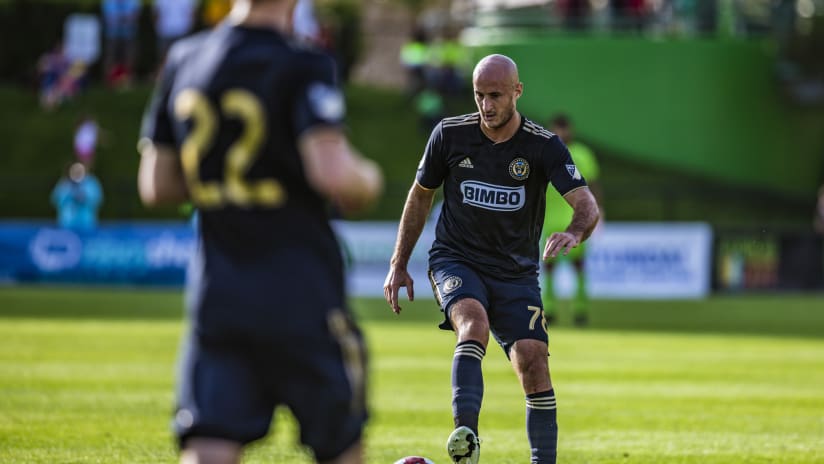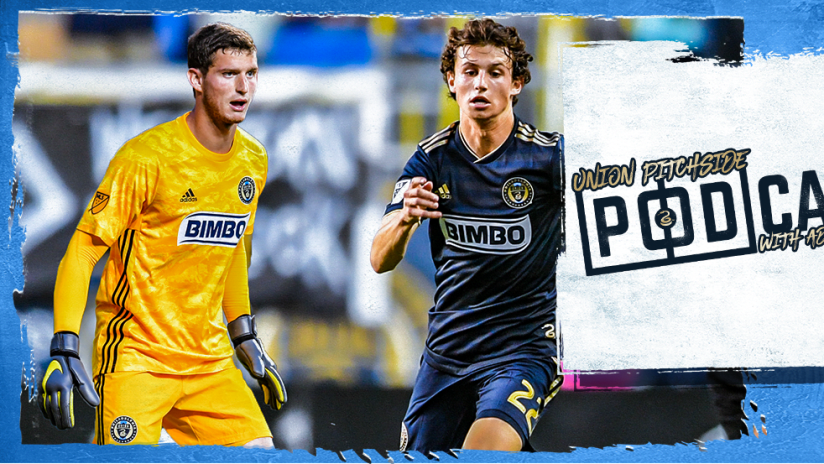In both matches against Chicago this season, Philadelphia Union have struggled against a strange defensive setup until a moment of brilliance opened the match up. The first time it was Ilsinho’s impossiblisto to round Bastian Schweinsteiger and Brandon Vincent, and on Wednesday it was Haris Medunjanin’s supremely cool tackle-touch-finish.
The Bosnian’s excellent situational read to press high with Cory Burke created the disrupted moment that the Union needed to break through a Fire team that refused to commit players forward. Although Chicago surged back to tie the match three times, once Philly broke their defense and they had to come out of their deep defense and play soccer, it was clear who the better team was.
Union continue to crush fullbacks that shouldn’t be fullbacks
It’s notable that Medunjanin dispossesses Jorge Campos, the right winger moved to right back after Kevin Ellis left with an injury. Campos’ loose touch would not be punished as severely if he made it 50-60 yards from goal, but as a defender every little mistake is one step away from being thrown in your face.
A recurring theme in MLS this season, and one that has helped the Union considerably, is coaches using attackers at fullback. The idea that fullbacks push forward to create width in the modern game has given rise to the tactical notion of using the fullback position to add an extra attacker to the lineup. This can be effective, but only in very specific circumstances.
Chicago controlled much of the ball throughout the first half, but they held it in their own half, close to their own goal. This is, of course, quite different from controlling the ball close to the opposition goal. Manchester City can use midfielders as fullbacks because they control play in the other team’s attacking third. This means the fullbacks are often in attacking positions, and when they need to play defense, they do so far from their own net, so others can drop and help them.
Chicago, Real Salt Lake, and Vancouver have all tried to use non-defenders as fullbacks in order to reap the offensive rewards of such a move. In each case, the Union have targeted and exposed that player. Here is Fafa Picault’s final third passing chart from Wednesday. Incompletes? Yup.

But look at where he’s getting off crosses: Low and close to the edge of the box. This is precisely where the Union want to be when they’re sending balls into the box, and Campos did not have enough experience to defend that area.
Picault had a quietly effective night more generally, too. Jim Curtin wanted him to attack dynamically, making both vertical and horizontal runs with the ball to disrupt Chicago’s man-marking system. By moving across the formation from left to right, Picault either pulled a Fire player with him or forced defensive switches that required very good communication.
One of those runs led to Cory Burke’s first half goal:
Dealing with Dockal
The Union also learned Wednesday evening that they can win even if teams successfully take Borek Dockal out of the match.
Chicago’s plan was clearly to limit the space Philly’s playmaker had and prevent him from turning upfield. Even when trailing, the Fire asked Dax McCarty to stay close to Dockal, and this made it hard for the Union to progress the ball through midfield. Take out the two passes from Ilsinho that occurred in the opening six minutes of the match and you’re left with three successful balls into the final third prior to Medunjanin’s goal. In other words, Chicago’s strategy was effective. But what were they doing?
In short: stay close together and hold a consistent line. You can see exactly where that line was in the image below.

The interesting aspect of this setup is that the Fire did not try to bunker and break like Vancouver, but instead they bunkered and mosey’d. After winnning the ball, the Fire very slowly moved it side to side until they a) drew the Union defense forward, and b) found Alexander Katai in space.
Look at the passing chart for Chicago’s midfield below. It’s almost all side to side, with the goal of ending up with an overload on the left that will allow Katai to pop open and drive at someone with the ball. As the Serbian winger showed, he can be deadly in such instances. But as a strategy, particularly at home, this seems to indicate a strange lack of trust in the team to play any sort of tactical system with nuance or complexity.

And in the end this is worth remembering: The Union gave up three total shots in the second half, and Chicago scored on two of them: A set piece and a sighter from distance. That is good defense on the road no matter how you cut it. It’s not perfect, mind you. But it’s good.

Final note on subs
Particularly notable is Jim Curtin’s 66th minute move to insert Warren Creavalle for Borek Dockal. The Fire were keying on Dockal, so by pulling him out the Union coach was asking whether Chicago could retain its understanding between players without a central reference point.
Generally, Dax McCarty and Brandt Bronico did well defensively once Dockal left the match. But Ale Bedoya started to find space deep in the right channel as the match progressed. Bedoya was moving a bit better than Dockal in this one, and he took advantage of Katai’s increasingly advanced positioning as the match wore on to slip behind Bronico when the Fire midfielder had to step forward to fill in areas that Katai should have occupied.
Overall, this was another strange matchup against the Fire. The Union were the better team, though, and that’s good news since there is still a chance these clubs meet once more this year. The Fire face Louisville City FC in the US Open Cup July 18, and if they win and Philly knocks off Orlando City SC, a US Open Cup semifinal matchup awaits.













